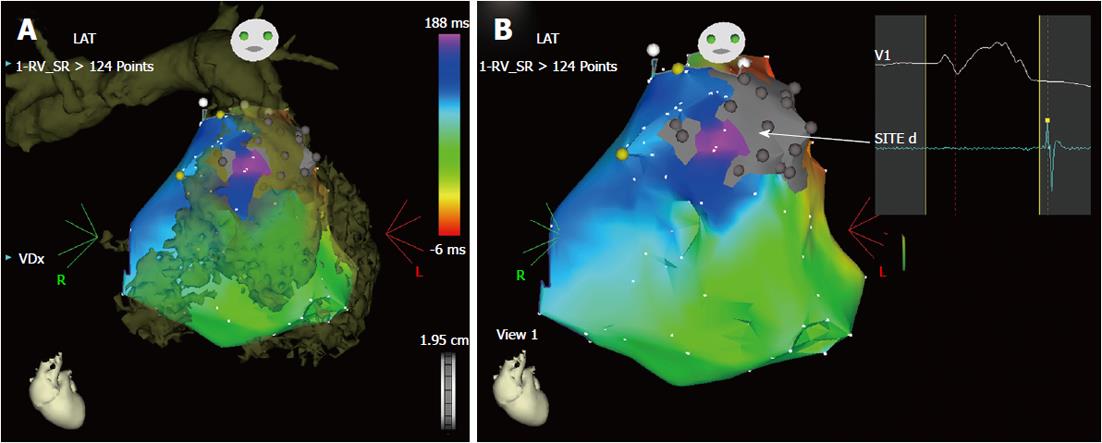Copyright
©2011 Baishideng Publishing Group Co.
World J Cardiol. Nov 26, 2011; 3(11): 339-350
Published online Nov 26, 2011. doi: 10.4330/wjc.v3.i11.339
Published online Nov 26, 2011. doi: 10.4330/wjc.v3.i11.339
Figure 3 Imaging integration for ablation of ventricular tachycardia (A, B).
Example of integration of a computed tomography image in the three-dimensional electroanatomic system. This patient had ventricular tachycardia years after multiple surgical corrections for tetralogy of fallot with pulmonary artery stenosis. He was referred for multiple recurrences of drug-refractory ventricular tachycardia with two morphologies, both with left bundle branch morphology and inferior axis deviation. However, no arrhythmia was inducible during the electrophysiology testing. Therefore, the ablation strategy was based on substrate mapping in sinus rhythm with imaging integration (Figure 4). A: The three-dimensional rendering of the computed tomography (image in brown) of the right ventricle and pulmonary artery is superimposed on the electroanatomic mapping of the right ventricle in sinus rhythm. The merging of the two images helps reconstruct the geometry of the heart chamber and, particularly in this case, clarifies the anatomy of the right ventricular outflow tract, identifying precisely the pulmonary valve annulus, an essential landmark for ablation. The right ventricle appears hypertrophic and markedly dilated; B: The activation map in sinus rhythm is shown in the antero-posterior projection without the integrated image. There is a markedly delayed activation in the anterior wall of the outflow tract (in purple), in a channel between two electrically silent areas (in gray) related to previous surgery (ventriculotomy and positioning of a prosthetic patch). This channel (arrow) shows late bipolar recordings, after the end of the surface QRS (panel on right hand side) and could possibly be related to one morphology of ventricular tachycardia. During sinus rhythm, the earliest activated site (in red) of the right ventricular endocardium is the ventricular septum, consistent with a breakthrough of activation from the left bundle branch in the presence of a complete right bundle branch block.
- Citation: Ponti RD. Role of catheter ablation of ventricular tachycardia associated with structural heart disease. World J Cardiol 2011; 3(11): 339-350
- URL: https://www.wjgnet.com/1949-8462/full/v3/i11/339.htm
- DOI: https://dx.doi.org/10.4330/wjc.v3.i11.339









